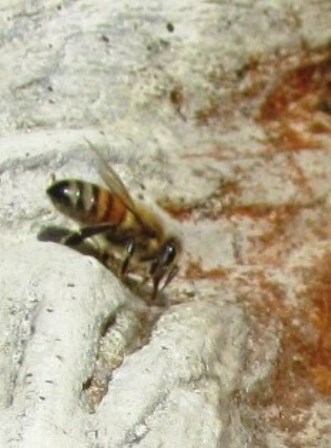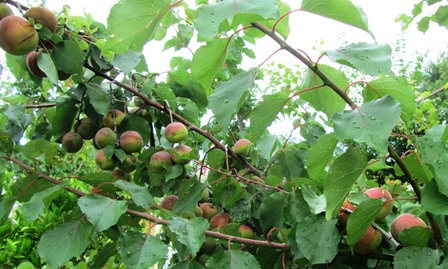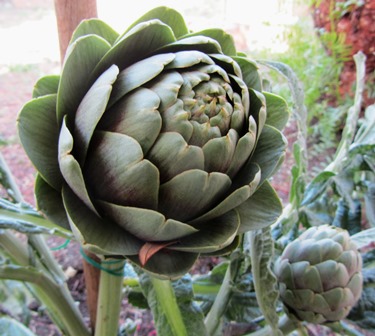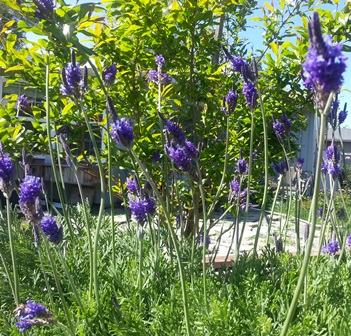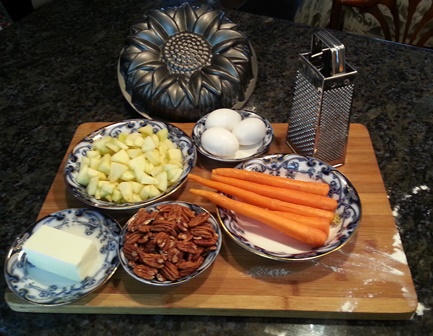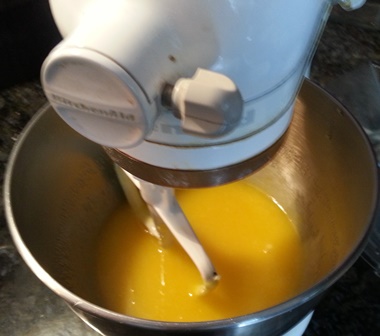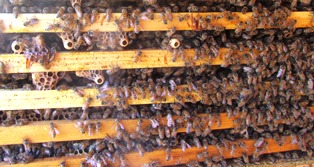Archive for March, 2016
Swarming Season 2016 Has Started
My beekeeper neighbor was working in his backyard this morning as I typed away on my novel. My office overlooks the garden and the fence between our properties.
Then . . . I heard the familiar clanging of a spoon against a pan. I leaped from my desk chair and ran to the kitchen. There, I grabbed a pot lid and wooden spoon and joined the banging at the fence between our properties.
I could see the brown cloud of honeybees in the air swarming near his apricot tree. We banged away for a while. It’s a bee-disorienting action that compels them to alight in a nearby tree or bush. “Have they landed yet,” I yelled. He replied that they had.
Thus begins the 2016 swarming season for the environs of the Henny Penny Farmette.
Helping Our Planet’s Pollinators
Our planet’s beleaguered honeybees spend their short lives pollinating many of earth’s diverse food sources. Without bees, many of the fruits and vegetables we love would have to be pollinated by hand–an impractical option because of the intensive work and expense. Food diversity would shrink while food prices rise.
We would suffer but so would animals and wild birds that eat berries, nuts, and seeds produced by bee pollination. There’s a simple way we all can help our bee pollinators–buy and plant a packet of flower seed that attracts the bees.
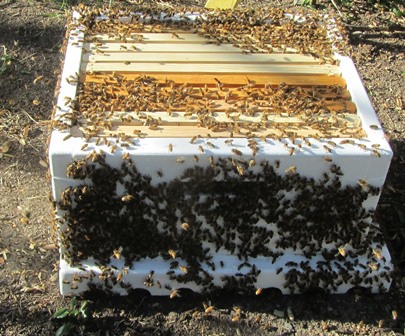
Honeybees summon other bees from the swarm by doing a “waggle dance” around the top of prepared hive box
Botanical Interests, Inc., a company in Colorado, has made it easy to help the bees. The company has created a seed mixture of plants known to attract bees. Labeled as “Save the Bees,” the package makes it easy to grow plants bees love. See, https://www.botanicalinterests.com/products and search for “Save the Bees.”
The company also sells individual packets of flower seed that attracts pollinators, but the advantage of the “Save the Bees” package is that you’ll also get herbs (dill, sweet basil, and lemon mint) with your flowers. The packet contains 100 percent seed without fillers. All seeds are non-GMO and untreated. Best of all, the packet covers approximately 225 square feet and includes the following plants:
- Borage
- Sunflower, Lemon Queen
- Siberian Wallflower
- Dill
- Coreopsis, Lance Leaf
- California Poppy
- Gaillardia, Annual
- Zinnia, Lilliput
- Basil, Sweet
- Cosmos
- Purple Prairie Clover
- Globe Gilia
- Catnip
- Lemon Mint
- Black-Eyed Susan
- Goldenrod
- Lavender Hyssop
- Bergamot
Roughly eight of the plants are perennials, meaning they’ll return each year. At $4.99, it’s a deal! I purchased a couple of packets and sowed the seed in two raised beds. The seeds germinated within the specified period of 7-21 days. It’s my way of helping our planet’s little pollinators!
If you enjoy reading about keeping bees, raising chickens, creating delicious recipes and a bit of murder along the way, check out my offers from Kensington Publishing, available online and in tradition bookstores everywhere.
Growing Your Own Superfoods
Nutrient-rich fruits, vegetables, and berries are not difficult to grow. Some can even be grown in containers on a sunny patio. My favorite superfoods include blueberries, strawberries, raspberries, and blackberries as well as artichokes, assorted leafy greens, and figs. But in general, superfoods are those foods rich in nutrients, vitamins, fiber, antioxidants, and/or omega-3 and omega-6 fatty acids.
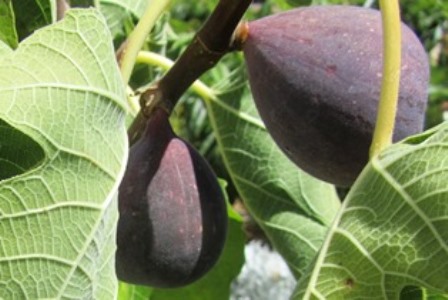
The dark purplish color is characteristic of the brown turkey fig, and this tree needs a lot of space in the garden
On the farmette, I’ve planted several fig trees that are semi-dwarf and include White Genoa, Brown Turkey, and Mission varieties. These trees produce two crops each year–one in spring and the other in the fall. The fruits can be dried or eaten fresh and contain omega-3 and omega-6 fatty acids and phenol for the prevention and treatment of coronary heart disease.
I’ve planted raised beds of strawberries, including Albion, a variety that produces berries from June to October, and Sequoia, a dependable berry that produces fruit from June to early frost.
In half barrels, I’ve amended soil and planted thornless raspberries and blackberries. I like growing them in containers with trellis support because otherwise they spread all over any area of the garden where they’re planted.
We planted one artichoke a couple of years ago. It dies back in late fall only to return in the spring as a new plant with shoots containing the small chokes. Artichokes are low in calories and aid in the lowering of cholesterol because of specific compounds found in the edible parts of the plant.
Early in the spring when I put in my sweet garden peas, I also plant leafy greens such as kale, collards, lettuces, and spinach. Some of these come back the next year after their growing season is over.
Blueberries are easy to grow when you remember to plant them in acid soil. These berries are considered a superior brain food. They are low in calories (84 calories per cup) and provide about 24 percent of the suggested daily amount of Vitamin C that the body needs.
Except for the fig trees and the artichokes that do better in areas of the garden where they have plenty of space to spread, the other nutrient-rich foods mentioned can all be planted and raised in containers. It’s so easy to grow most of these plants, why not give it a try.
Fern-leaf Lavender Is Easy to Grow and Re-seeds
My hubby brought home several Lavandula multifida plants in five-gallon pots. Also known as Egyptian lavender or Fern-leaf lavender, the plant’s foliage appears fernlike, hence its common name.
The Fern-leaf lavender carries its bluish-purple bloom on three- to five-inch spikes. It’s a pretty plant in the garden, however, its scent is not of lavender as one might expect but rather more like oregano. The foliage is more pungently scented than the buds.
This evergreen perennial is classified as a sub-shrub. In cold climates, the frost kills it. However, it can be grown as an annual. In California and Arizona, the plant blooms from spring through late summer into fall. The blooms are tri-pronged.
These plants reach a height of about 24 inches. They are among the 39 species of lavender that belong to the genus Lavandula in the family of Labiatae (a family which also includes mint, rosemary, thyme, sage, savory, and basil).
The Fern-leaf lavender (like other species of Lavandula) attracts bees, butterflies, and other pollinators. It’s a lovely plant that will provide spectacular color in any garden or around a pool.
For more gardening tips, delicious recipes, farm sayings, and a fun mystery, check out my Henny Penny Farmette series of cozy mysteries, including A BEELINE TO MURDER, and THE MURDER OF A QUEEN BEE.
My books are available on Amazon, Barnesandnoble.com, and other online and traditional bookstores. See, http://www.amazon.com/Beeline-Murder-Henny-Farmette-Mystery/dp/161773909X/ref=sr_1_3?s=books&ie=UTF8&qid=1458077651&sr=1-3&keywords=Meera+Lester
Rainy Day Treat–Tea and Cake
The storms have been steadily sweeping over the farmette, thanks to the El Nino effect. And on rainy days, I like to ride out the battering rain and blustery winds with indoor work. Invariably, a tea break calls for cake.
I’m particularly fond of apple cake and this recipe adds a cream cheese layer which makes the cake super moist. The praline frosting with toasted pecans partners perfectly with the apples and spices.
William Tell’s Never Miss Apple Cake
Ingredients (for the cream cheese layer):
1 8-ounce package of cream cheese, softened
1/4 cup granulated sugar
1 egg
Ingredients (for the cake)
1 ¾ cups sugar
1 cup canola oil
3 large eggs
2 cups all-purpose flour
2 teaspoons baking powder
2 teaspoons ground cinnamon
1 teaspoon Kosher salt
¼ teaspoon baking soda
2 cups peeled, cored, and chopped Granny Smith apples
1 cup shredded carrots
½ cup chopped pecans, toasted
Ingredients (for the icing):
½ cup packed brown sugar
¼ cup butter, cubed
2 tablespoons whole milk
½ cup confectioner’s sugar
½ teaspoon vanilla extract
¼ cup chopped pecans, toasted
Directions for the prep:
1. Preheat oven to 350 degrees Fahrenheit.
2. Grease and flour a 10-in. fluted tube pan.
3. In a small bowl, cream together the cream cheese and sugar until smooth and then beat in egg.
Directions to make the cake:
1. Fit the large bowl to an electric mixer.
2. Add to the bowl the sugar, oil and eggs and beat to blend well.
3. In another large bowl, whisk together the flour, baking powder, cinnamon, salt and baking soda.
4. Add gradually the flour-and-spice mixture to the sugar-oil mixture.
5. Stir in apples, carrots and toasted pecans.
6. Pour one-half of the batter into the prepared pan.
7. Pour the cream cheese mixture on top of the batter and spread it evenly into a layer.
8. Add the remaining batter to the cream cheese layer.
9. Bake 60 minutes or until a toothpick inserted in cake portion comes out clean.
10. Cool cool completely before inverting the fluted pan to remove the cake.

The praline icing drizzled over the top tastes great but diminishes the contours of the sunflower petals
Directions to make the praline icing:
1. Combine brown sugar, butter and milk in a large saucepan and bring to a boil.
2. Boil the mixture, stirring constantly, for 1 minute and then remove the pan from heat.
3. Use a whisk to combine confectioners’ sugar with vanilla until smooth.
4. Drizzle the frosting over the cake.
5. Sprinkle with toasted pecans.
Serves: 12
For more delicious farmette recipes, folksy sayings, farming tips, and a cozy mystery, check out A BEELINE TO MURDER and the forthcoming THE MURDER OF A QUEEN BEE (Kensington Publishing), available on Amazon, BarnesandNoble.com and other online and traditional bookstores everywhere.
The Bees Won’t Wait
With so many flowers in bloom now, it’s time to add supers to the hives.
I can hear the buzzing from my patio, about twenty to thirty feet from the hives. My bees want to make honey, raise babies, and swarm . . . I know it.
My neighbor and I are opening hives tomorrow, but I worked out in the apiary today getting extensions (known as supers) ready. These have shorter frames and the bees use them to build wax cells and store honey.
I’ve got two active hives and extras. And I have several supers, complete with the shorter frames ready to go.
There are about ten frames I can use in a super that are being housed in the outdoor freezer. It’s where I put frames to kill anything that could live over on them that I don’t want in a hive, like a wax moth. The cold kills.
I also cleaned the bee glue off another hive box with larger frames in the event the bees decide to swarm sooner rather than later. The bees won’t wait. They’ll need a new house ready when they swarm or they’ll fly away and find one elsewhere.
 Facebook
Facebook Goodreads
Goodreads LinkedIn
LinkedIn Meera Lester
Meera Lester Twitter
Twitter





